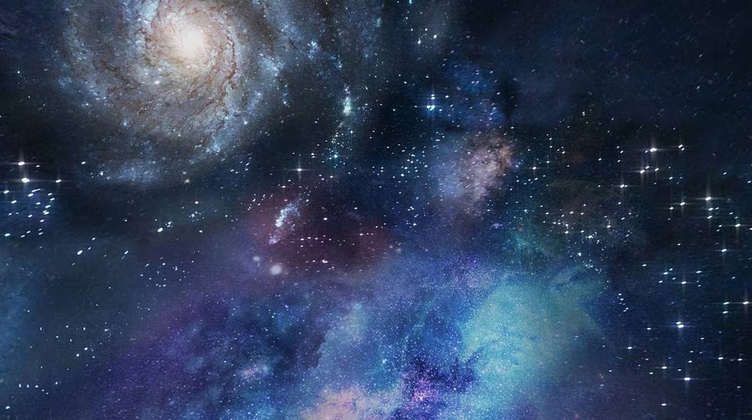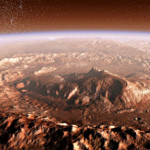Exploring the unknown out of curiosity is a driving force hidden deep within every individual. It compels us to continuously seek answers and venture into uncharted territories. This curiosity propels humanity forward, not only on Earth but also into the vast interstellar realm of the universe. In the vast depths of the cosmos, many astonishing mysteries and grand landscapes lie concealed, and one of the most remarkable among them is the Hercules-Corona Borealis Great Wall.
The Hercules-Corona Borealis Great Wall is a magnificent cosmic structure composed of galaxies, spanning over 10 billion light-years, making it one of the largest known observable structures in the universe. However, this astounding discovery was not the result of extensive planning and strategizing but rather a serendipitous find. Its story begins in November 2013 when astronomers were studying gamma-ray bursts in the distant cosmos. Gamma-ray bursts are one of the most energetically intense astronomical events in the universe, often associated with the explosive deaths of massive stars. These events are relatively rare in the cosmos, occurring on average once every few million years even in galaxies similar to our Milky Way. Therefore, astronomers considered gamma-ray bursts as clues to uncover hitherto undiscovered structures in the universe.
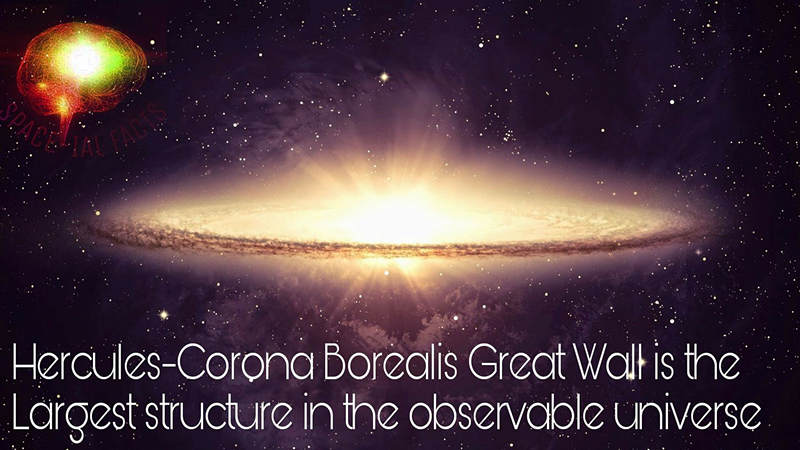
They used observations from the Fermi Gamma-ray Space Telescope and the Swift satellite to create a distribution map of gamma-ray bursts. However, while analyzing the data, they stumbled upon some anomalies. In this data, 14 gamma-ray bursts were concentrated within a region spanning 45 degrees in width, corresponding to one-eighth of the sky, and their redshift values (a measure of the distance to cosmic objects) ranged from 1.6 to 2.1, roughly equivalent to a distance of about 10 billion light-years from Earth. This piqued the interest of astronomers significantly because the number and density of gamma-ray bursts in this region far exceeded expectations. Scientists began to ponder what could be causing such a concentrated distribution of gamma-ray bursts in this area.
To unravel this mystery, they embarked on deeper research and analysis, employing scientific methods and observational tools to explore this region. Gradually, they unveiled the secret behind this region, discovering that it was not the result of a series of random events but rather the presence of a colossal cosmic structure. This structure has been aptly named the “Hercules-Corona Borealis Great Wall” because its projected location on the celestial sphere lies between the constellations Hercules and Corona Borealis.
The discovery of the Hercules-Corona Borealis Great Wall has sparked extensive research and discussion. Firstly, it challenges one of the fundamental principles of cosmology, the isotropy of the universe. According to this principle, the universe should be uniform on sufficiently large scales, meaning that there should not be significant variations in the density of matter between different regions. However, the existence of the Hercules-Corona Borealis Great Wall suggests that, at certain scales, the universe is not uniform, posing a challenge to the fundamental principles of cosmology.
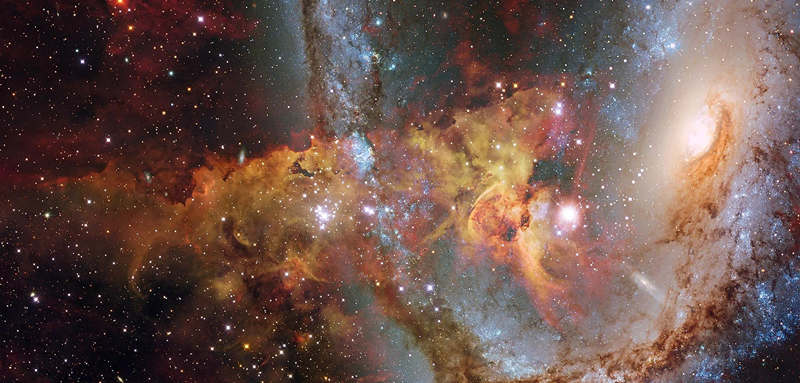
Furthermore, it raises questions about models of cosmic evolution. According to existing cosmological theories, such a massive structure should not have formed within the time since the birth of the universe, as it would require more time for the accumulation of matter on this scale. However, the existence of the Hercules-Corona Borealis Great Wall contradicts this model, prompting scientists to reconsider the way the universe has evolved.
The discovery of the Hercules-Corona Borealis Great Wall also serves as a reminder that despite the tremendous progress humans have made in the fields of science and technology, there are still many unknowns waiting to be explored in the universe. The existence of this massive cosmic structure is one of the many mysteries in the cosmos, and it inspires scientists to pursue deeper research and exploration of the universe. As we continue to explore the unknown and unravel the mysteries of the universe, it is the driving force of human curiosity that propels scientific advancement and provides us with a deeper understanding of the cosmos. The Hercules-Corona Borealis Great Wall, like a glittering gem in the universe, leads us to delve deeper into the mysteries of the cosmos.
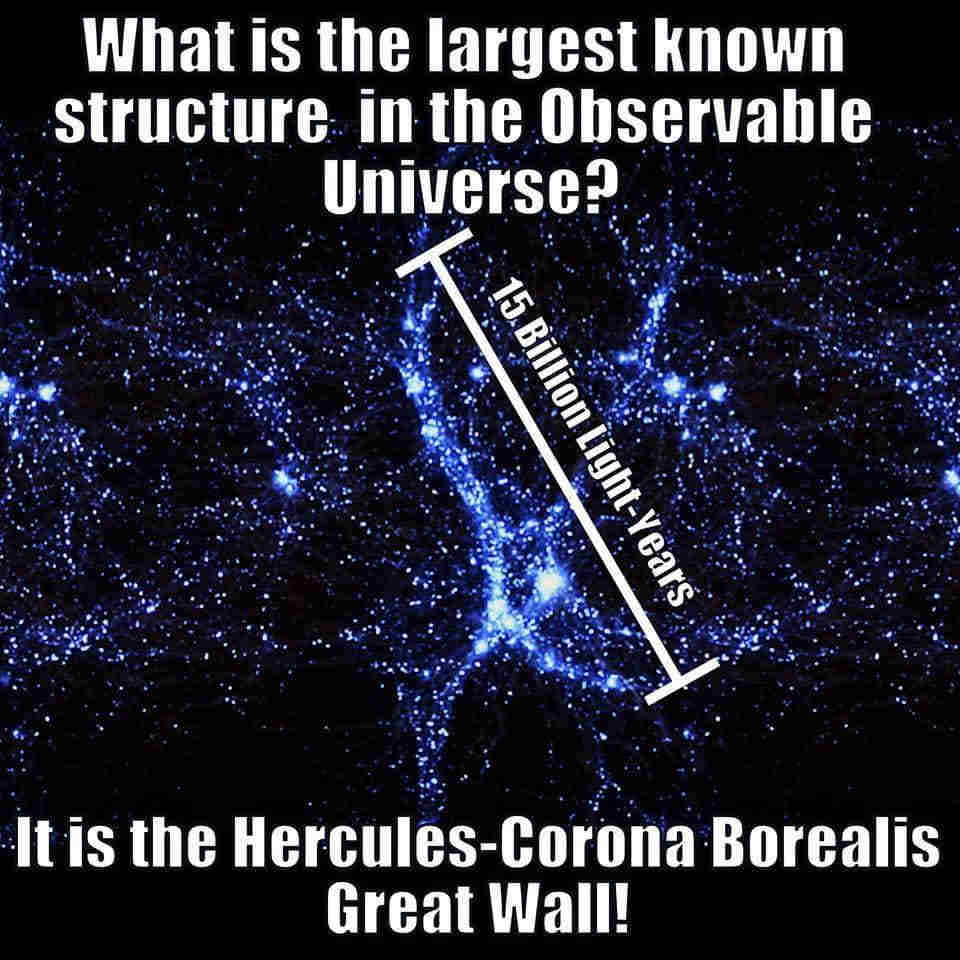
As we delve further into the magnificent structure of the Hercules-Corona Borealis Great Wall in the cosmos, here are more detailed descriptions of the 15 facts mentioned earlier:
- Overview of the Hercules-Corona Borealis Great Wall: The Hercules-Corona Borealis Great Wall is a colossal cosmic superstructure composed of galaxies, with a total length exceeding 10 billion light-years. It is considered the largest known single structure in the observable universe. This immense cosmic wall is, in fact, an assemblage of galaxy clusters interconnected by gravity.
- Naming of the Great Wall: Its name, “Hercules-Corona Borealis Great Wall,” derives from its position on the celestial sphere, spanning across the constellations Hercules and Corona Borealis.
- Discovery Time: The Hercules-Corona Borealis Great Wall was first discovered in November 2013. This discovery was made by analyzing the distribution map of gamma-ray bursts.
- Length of the Structure: The length of the Hercules-Corona Borealis Great Wall is extraordinarily astounding. Its longest section spans approximately 10 billion light-years, while the shorter end is still an impressive 7.2 billion light-years long. This makes it one of the largest known structures to humanity, and its sheer size is almost incomprehensible.
- Redshift Values: The redshift values of this cosmic wall range from 1.6 to 2.1, corresponding to a distance of about 10 billion light-years from Earth. Redshift is a method used to measure the distance of celestial objects, indicating that objects farther from us exhibit a redder shift in their spectra, a consequence of the universe’s expansion.
- Role of Gamma-Ray Bursts: Gamma-ray bursts played a crucial role in this discovery. These intensely bright events release enormous energy in the cosmos and are typically associated with the deaths of massive stars. Their presence can be used to trace the distribution of matter in the universe.
- Analytical Approach: To discover the Hercules-Corona Borealis Great Wall, scientists analyzed data from gamma-ray burst observations spanning from 1997 to 2012. They divided the universe into nine regions, each containing 31 gamma-ray burst events. Among these, 14 gamma-ray bursts were concentrated within a 45-degree-wide region, with redshift values ranging from 1.6 to 2.1.
- Challenge to Uniformity: This discovery has raised questions about the uniformity of the universe in cosmology. According to cosmological principles, the universe should be uniform on sufficiently large scales. However, the existence of the Hercules-Corona Borealis Great Wall suggests that the universe is not uniform at certain scales, challenging fundamental cosmological principles.
- Issues with Cosmic Evolution: The discovery of the Hercules-Corona Borealis Great Wall also raises questions regarding models of cosmic evolution. According to current cosmological theories, such a massive structure should not have formed within the relatively short time since the birth of the universe, as it would require more time to accumulate matter on this scale. This challenges existing models of cosmic evolution, forcing scientists to reconsider how the universe has evolved.
- Age of the Universe: Considering that the age of the universe is only 13.8 billion years, the existence of the Hercules-Corona Borealis Great Wall implies that it formed in an exceptionally short period. This is surprising because, according to cosmological theories, a structure of this immense scale would require more time to form.
- Scale of Cosmic Uniformity: Scientists typically use the scale of uniformity to describe the evenness of the universe. The current best-fit value for this scale is approximately 250 to 300 million light-years. This suggests that, at this scale, the universe should be uniform. However, the length of the Hercules-Corona Borealis Great Wall far exceeds this scale, surpassing it by over eightfold, equivalent to 10.7% of the observable universe.
- Upper Limit of Uniformity Scale: Considering the cosmic density constant determined by cosmic microwave background radiation, the upper limit of the uniformity scale is around four times the best-fit value, or 1 to 1.2 billion light-years. This indicates that, according to cosmological principles, structures larger than this upper limit should not exist.
- Other Similar Structures: In addition to the Hercules-Corona Borealis Great Wall, other similar colossal cosmic structures have been discovered, such as the Corona-Borealis Supercluster, the Sloan Great Wall, and the Huge Large Quasar Group (Huge-LQG).
- Challenging the Uniformity Issue: The existence of the Hercules-Corona Borealis Great Wall challenges cosmological principles. Cosmological principles assume that, on sufficiently large scales, the universe is uniform and isotropic. However, this discovery indicates that the distribution of the universe is non-uniform at certain scales, prompting scientists to reconsider cosmic evolution and uniformity.
- Future Observations and Research: Scientists will continue to observe and research the Hercules-Corona Borealis Great Wall to gain a deeper understanding of its nature and formation mechanism. This colossal cosmic structure remains shrouded in mystery, challenging our existing theories of cosmic evolution. Therefore, more observational data and theoretical research are needed to unravel these mysteries.
In summary, the discovery of the Hercules-Corona Borealis Great Wall is not only awe-inspiring but also raises significant questions in cosmology and cosmic evolution. The existence of this colossal cosmic structure not only alters our perception of the universe but also fuels the curiosity and enthusiasm of scientists to delve deeper into cosmic exploration. As future research and observations progress, we hope to gain a more comprehensive understanding of this mysterious and magnificent cosmic wall.
More UFOs and mysterious files, please check out our YouTube channel: MysFiles
